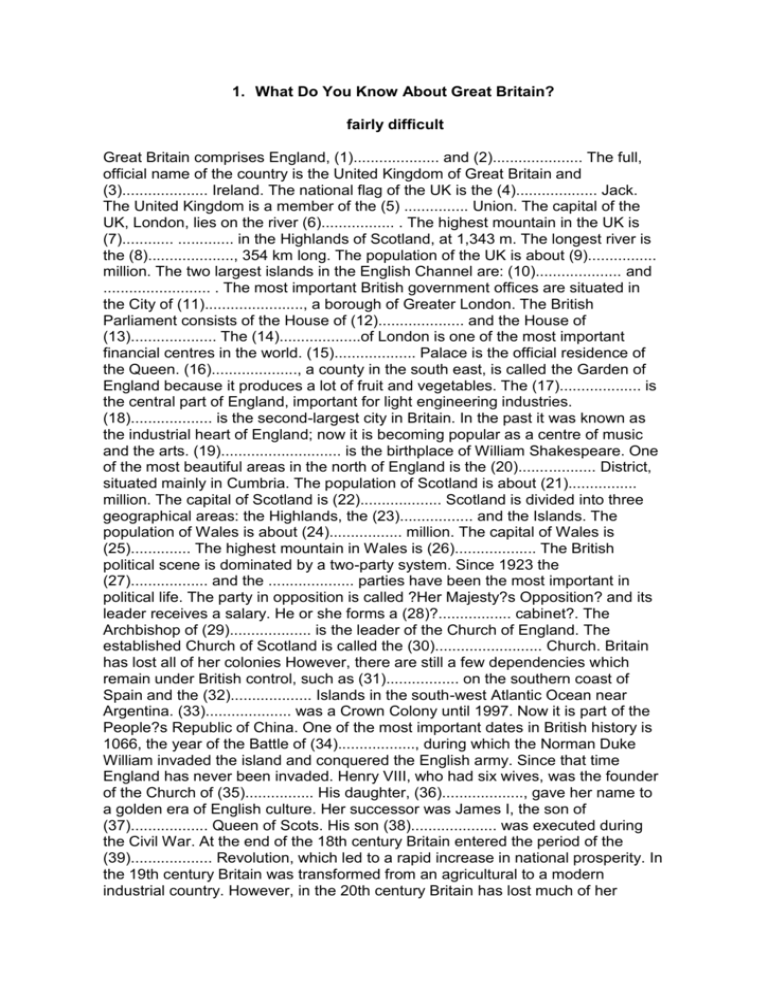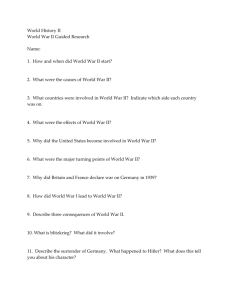Quiz 3 - www.rinablijdorp.nl.
advertisement

1. What Do You Know About Great Britain? fairly difficult Great Britain comprises England, (1).................... and (2)..................... The full, official name of the country is the United Kingdom of Great Britain and (3).................... Ireland. The national flag of the UK is the (4)................... Jack. The United Kingdom is a member of the (5) ............... Union. The capital of the UK, London, lies on the river (6)................. . The highest mountain in the UK is (7)............ ............. in the Highlands of Scotland, at 1,343 m. The longest river is the (8)...................., 354 km long. The population of the UK is about (9)................ million. The two largest islands in the English Channel are: (10).................... and ......................... . The most important British government offices are situated in the City of (11)......................., a borough of Greater London. The British Parliament consists of the House of (12).................... and the House of (13).................... The (14)...................of London is one of the most important financial centres in the world. (15)................... Palace is the official residence of the Queen. (16)...................., a county in the south east, is called the Garden of England because it produces a lot of fruit and vegetables. The (17)................... is the central part of England, important for light engineering industries. (18)................... is the second-largest city in Britain. In the past it was known as the industrial heart of England; now it is becoming popular as a centre of music and the arts. (19)............................ is the birthplace of William Shakespeare. One of the most beautiful areas in the north of England is the (20).................. District, situated mainly in Cumbria. The population of Scotland is about (21)................ million. The capital of Scotland is (22)................... Scotland is divided into three geographical areas: the Highlands, the (23)................. and the Islands. The population of Wales is about (24)................. million. The capital of Wales is (25).............. The highest mountain in Wales is (26)................... The British political scene is dominated by a two-party system. Since 1923 the (27).................. and the .................... parties have been the most important in political life. The party in opposition is called ?Her Majesty?s Opposition? and its leader receives a salary. He or she forms a (28)?................. cabinet?. The Archbishop of (29)................... is the leader of the Church of England. The established Church of Scotland is called the (30)......................... Church. Britain has lost all of her colonies However, there are still a few dependencies which remain under British control, such as (31)................. on the southern coast of Spain and the (32)................... Islands in the south-west Atlantic Ocean near Argentina. (33).................... was a Crown Colony until 1997. Now it is part of the People?s Republic of China. One of the most important dates in British history is 1066, the year of the Battle of (34).................., during which the Norman Duke William invaded the island and conquered the English army. Since that time England has never been invaded. Henry VIII, who had six wives, was the founder of the Church of (35)................ His daughter, (36)..................., gave her name to a golden era of English culture. Her successor was James I, the son of (37).................. Queen of Scots. His son (38).................... was executed during the Civil War. At the end of the 18th century Britain entered the period of the (39)................... Revolution, which led to a rapid increase in national prosperity. In the 19th century Britain was transformed from an agricultural to a modern industrial country. However, in the 20th century Britain has lost much of her economic and political power. In 1979, the Conservative government under Mrs. (40) .................. was determined to improve the economic situation of the country, which was partly achieved. At present the British (41) ................ is one of the strongest world currencies. 2. Write in the missing dates. 1. The Armada is the name of the Spanish fleet that was defeated by the English navy in ...... . 2. The Act of Supremacy was passed in ...... and declared the sovereign to be the secular head of the Church of England. 3. The Titanic was a British passenger liner which collided with an iceberg on her maiden voyage to New York in ...... . 4. The final battle of the Napoleonic Wars, which was in ......, is called the Battle of Waterloo. 5. A famous battle in English history, in which William the Conqueror defeated the Anglo-Saxon King Harold near Hastings in ......, is called the Battle of Hastings. 6. Magna Carta is the charter granted by King John in ......, which recognised the rights and privileges of the barons, the Church and the freemen. 7. The present sovereign, Queen Elizabeth, had her Coronation in ...... . 8. An epidemic of bubonic plague in London in ......, when more than 70,000 people died, out of an estimated population of 460,000 is called the Great Plague of London. 9. The Battle of Britain was the battle between British and German aircraft over London and the south of England in ...... . 10. A fire which destroyed more than a half the city of London, including the old St Paul's Cathedral, in ...... is called the Great Fire of London. 3. Choose the correct answer. 1. Anne Hathaway's Cottage is the old house near ..... in which Shakespeare's wife was born. a) London b) Oxford c) Cardiff d) Stratford-upon-Avon 2. The highest mountain in Wales is called ..... . a) Snowdon b) Ben Nevis c) Skiddaw d) High Willhays 3. Hadrian's Wall is an ancient wall built by order of the Roman emperor Hadrian in the ..... century AD to defend the northern border of England against attacks by Celtic tribes. a) 1st b) 4th c) 2nd d) 3rd 4. The wars in ..... between the house of York and the house of Lancaster are called the Wars of the Roses. a) the first half of 15th century b) the second half of 15th century c) the first half of 14th century d) the second half of 14th century 5. The English Civil War is the war between the Cavaliers and the Roundheads in ..... . a) the mid-17th century b) the mid-18th century c) the mid-16th century d) the mid-15th century 6. The Battle of Trafalgar was a decisive naval battle that took place off Cape Trafalgar on ..... . a) 06/06/1944 b) 21/10/1805 c) 11/11/1918 d) 05/11/1605 7. The Golden Age took place in ..... . a) the mid-15th century b) the second half of the 17th century c) the second half of the 16th century d) the mid-18th century 8. D-day was on ..... when Anglo-American troops landed in Normandy. a) 06/06/1944 d) 05/11/1605 c) 11/11/1918 d) 15/09/1940 9. The Globe Theatre was built in ..... on the South bank of the Thames, London. a) 1666 b) 1707 c) 1588 d) 1599 10. The Act of Union was passed in ..... and declared the union of England and Scotland. a) 1666 b) 1707 c) 1588 d) 1599









